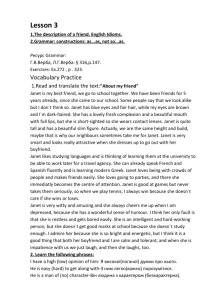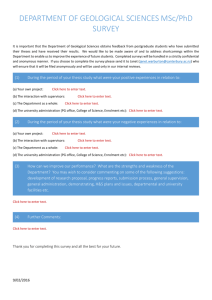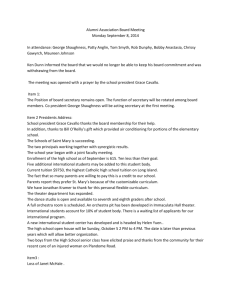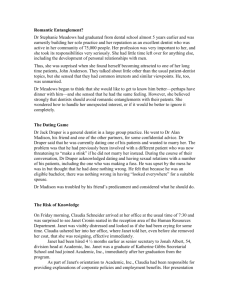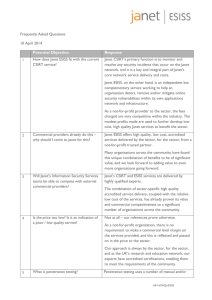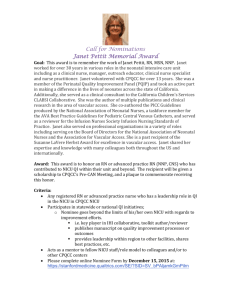divided opinion within the 1944-46 Royal Commission on Equal Pay
advertisement
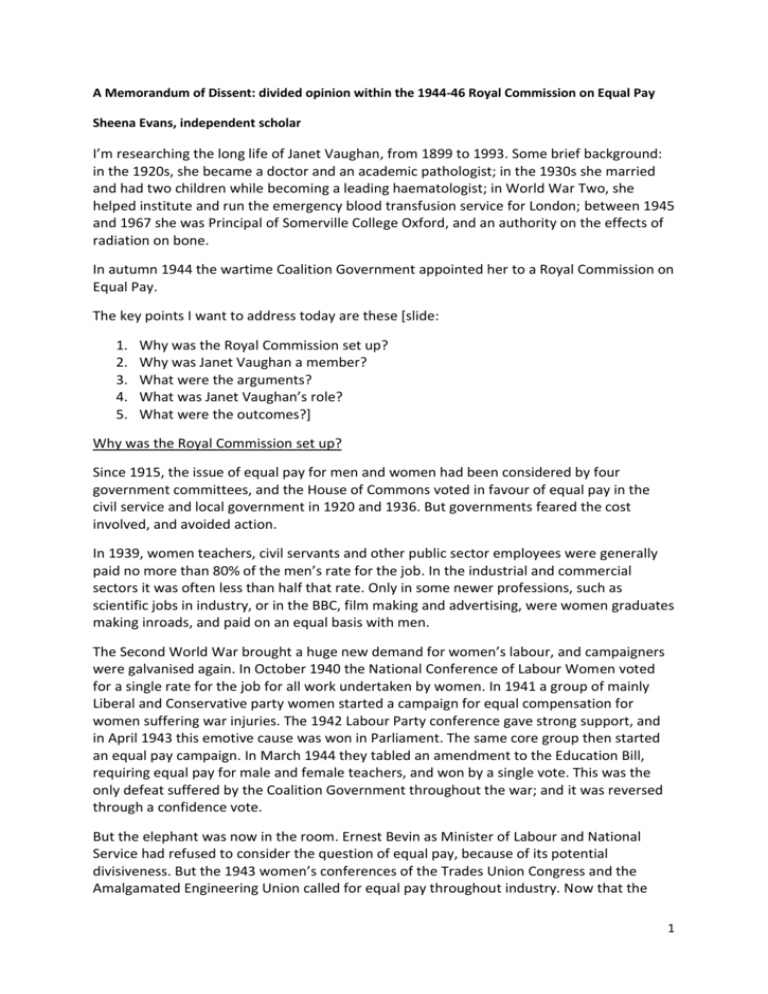
A Memorandum of Dissent: divided opinion within the 1944-46 Royal Commission on Equal Pay Sheena Evans, independent scholar I’m researching the long life of Janet Vaughan, from 1899 to 1993. Some brief background: in the 1920s, she became a doctor and an academic pathologist; in the 1930s she married and had two children while becoming a leading haematologist; in World War Two, she helped institute and run the emergency blood transfusion service for London; between 1945 and 1967 she was Principal of Somerville College Oxford, and an authority on the effects of radiation on bone. In autumn 1944 the wartime Coalition Government appointed her to a Royal Commission on Equal Pay. The key points I want to address today are these [slide: 1. 2. 3. 4. 5. Why was the Royal Commission set up? Why was Janet Vaughan a member? What were the arguments? What was Janet Vaughan’s role? What were the outcomes?] Why was the Royal Commission set up? Since 1915, the issue of equal pay for men and women had been considered by four government committees, and the House of Commons voted in favour of equal pay in the civil service and local government in 1920 and 1936. But governments feared the cost involved, and avoided action. In 1939, women teachers, civil servants and other public sector employees were generally paid no more than 80% of the men’s rate for the job. In the industrial and commercial sectors it was often less than half that rate. Only in some newer professions, such as scientific jobs in industry, or in the BBC, film making and advertising, were women graduates making inroads, and paid on an equal basis with men. The Second World War brought a huge new demand for women’s labour, and campaigners were galvanised again. In October 1940 the National Conference of Labour Women voted for a single rate for the job for all work undertaken by women. In 1941 a group of mainly Liberal and Conservative party women started a campaign for equal compensation for women suffering war injuries. The 1942 Labour Party conference gave strong support, and in April 1943 this emotive cause was won in Parliament. The same core group then started an equal pay campaign. In March 1944 they tabled an amendment to the Education Bill, requiring equal pay for male and female teachers, and won by a single vote. This was the only defeat suffered by the Coalition Government throughout the war; and it was reversed through a confidence vote. But the elephant was now in the room. Ernest Bevin as Minister of Labour and National Service had refused to consider the question of equal pay, because of its potential divisiveness. But the 1943 women’s conferences of the Trades Union Congress and the Amalgamated Engineering Union called for equal pay throughout industry. Now that the 1 tide had turned in the war, workers started to protest about grievances: there had been a strike over equal pay in Scotland in autumn 1943. So in May 1944, a Royal Commission was announced. Why? Partly because the subject was complex and controversial. A Royal Commission was semi-independent of government and would act in a quasi-judicial way. But members and terms of reference were chosen by ministers, and controversy would be damped down while it deliberated. The Chancellor of the Exchequer believed it ‘of vital importance that no final conclusion is reached until the stark realities of the post-war situation have exhibited themselves’. To give some idea of the potential cost involved, by mid-1945, nearly 50% of government and about 57% of local government employees were women. The terms of reference - “To examine the existing relationship between the remuneration of men and women in the public services, in industry and in other fields of employment: to consider the social, economic and financial implications of the claim of equal pay for equal work: and to report”- precluded the making of recommendations. The report would highlight estimated costs, and if its conclusions favoured equal pay in principle, government could not be held to account on specific recommendations. Why was Janet Vaughan a member? Unusually, this was a small, gender-balanced Commission – another sign that government wanted to be seen to take this seriously. The four women and four men were to include in each case an employer and trade unionist, an economist and a generalist with public sector experience; none publicly committed on equal pay. No suitable woman economist could be found, so Janet - since in theory medical women already had equal pay – was suggested as a medical woman with experience of public work. She was apparently ‘highly commended by the Ministry of Health … a useful member of the Hospitals Commission [actually she had served on the Interdepartmental Committee on Medical Schools], a married professional woman with children, a daughter of Vaughan of Wellington and Rugby…’, and so had ‘practical experience of public work and was brought up in an atmosphere of it’. Another medical candidate was preferred until Attlee as Deputy Prime Minister said there should be more than one married woman. So her headmaster father and her travel agent husband were crucial to her selection. What were the arguments? It was generally recognised that men and women in the public services and teaching did the same work under the same conditions; and they had strong trade unions in which female workers played a full part. The Commission concluded that implementing equal pay in these sectors was a matter of cost rather than principle. So I’ll concentrate on the more complex private and commercial sectors. Culture and tradition were hugely important. Male workers and predominantly male trade unions protected ‘male only’ employment sectors for fear that lower paid women might undercut men’s wages and/or take over their jobs. Employers acquiesced, to avoid antagonising the men and because of their general interest in keeping women’s – as well as men’s - pay low. 2 Employers, speaking mainly through the British Employers’ Confederation, justified the wage differential, and the separation of men’s and women’s work, primarily in medical terms. They claimed that women were: naturally less robust, and subject to the demands of menstruation, pregnancy, child bearing and rearing; more prone to sickness absence than men; less adaptable, so poor at dealing with sudden crises or changing conditions, and less able to carry out machine maintenance – so requiring more supervision and back-up; less committed to the work and of lower ‘career value’ because likely to leave after a few years on marriage. Those continuing or returning gave priority to home and family; limited by legal restrictions on their employment, such as the prohibition of night work in factories and exposure to certain poisonous substances. For these reasons, women were less efficient, so deserved lower pay. Janet was the only member with medical expertise. She thought these arguments tended to reflect ‘unexamined beliefs and prejudices’ and was authorised to consult suitable medical experts. They mostly agreed that there was no firm evidence that physiological differences between men and women substantively affected their relative efficiency, especially if methods and machinery were adapted to suit the generally inferior strength of women – and physically weaker men. The Medical Inspector of Factories said women’s exclusion from certain types of work owed more to custom than to physical need, and affected working class rather than professional women, who could afford domestic help. Although sickness rates appeared higher for women, this was not general: married women were more often sick than single ones, and factory workers more often than clerical staff. Overall, about 16% of the female workforce accounted for about two thirds of female sickness absence. Home responsibilities contributed to fatigue and ill health. But higher pay could only produce benefits. Janet’s own experience supported these conclusions. Anyone who worked in a hospital and virtually all nurses were female – was used to night work, sudden crises and rapid improvisation. Her wartime blood transfusion depot was on the trading estate at Slough, where before the war, 32% of the workforce were women, in industries like light engineering, pharmaceuticals and food processing. There were now far more, mostly producing armaments. The idea that they were not adaptable was laughable. Ernest Bevin said in February 1945: ‘We thought it would need three women for the output of two men, but by the help of our production engineers … the output is almost equal one for one.’ The Commission’s only economist was Dennis Robertson, Professor of Political Economy at Cambridge. A conservative thinker, he had fallen out with Maynard Keynes in the 1930s when Keynes departed from classical economic theory. Robertson led in drafting the final report, which reflected his views. In brief: given the low demand for women’s labour, despite the relatively low numbers seeking employment, it must follow that employers preferred men to women, as they said, because men were more efficient. And women’s inferior physical strength, 3 and virtual exclusion from heavy industries, meant that supply of their labour in other fields, like nursing, was increased relative to the demand for it; women’s inferior adaptability meant that, in ‘overlap’ areas where both sexes were employed on similar work, employers still preferred the more expensive men because ‘the average man’ was more efficient than 'the average woman’; it followed that granting equal pay would have the effect, especially in times of high unemployment, of displacing women from ‘overlap’ areas. When they were employed, it would put more money in women’s pockets without any increase in productivity, so its effect would be inflationary. Most of the economists consulted broadly supported this thesis, apart from one in particular: Joan Robinson, then a senior lecturer at Cambridge. Like Robertson, she was internationally respected for her published work. But she was one of the younger economists who supported Keynes. Joan Robinson argued that women’s pay rates were kept low primarily by their poor bargaining power. Where they did similar work, they were probably more efficient than men, so would not be displaced if paid the rate for the job. Janet and two of the three other women members refused to let Joan Robinson’s paper be dismissed as Dennis Robertson wished. Its arguments chimed with those of the Trades Union Congress. Whereas the British Employers’ Confederation said that women earned less than men even when – as in parts of the engineering and textiles industries – they were on equal piece rates; the Trades Union Congress argued that women were at least as efficient and that in practice, men were given higher paying work. There was no hard evidence to support or refute these mutually contradictory claims. In October 1945 the Commission considered seeking further work from some academics who had previously looked at the textiles industry. Janet said this would take longer than the two months they had in mind for finalising their report, but persuaded the majority that they must do it. An academic who had studied the cotton weaving industry confirmed that there, discrimination in favour of men caused unequal earnings on equal piece rates. What was Janet’s role? By autumn 1945, Janet seemed to have the majority of the Commission on her side. Dame Anne Loughlin, the trade unionist, and the employer Lucy Nettlefold, were her strongest allies. The male employer, Charles Robinson, was Director General of Filling/munitions Factories. In July 1945, he challenged the British Employers’ Confederation on the pay disparity, saying: ‘My experience … of women working side by side with men has been … considerable, and frankly I have been surprised … I could almost … say that fundamentally women … have produced … at least as much as men … and even more … in spite of …these horrible wartime conditions where … women have been doing two jobs with long periods of travelling in between … a job … for most of the day and then having to look after the children at home…’. In other words, the efficiency gap, if it existed, in no way corresponded to the pay gap. The male trade unionist, John Brown, was parliamentary officer for the Civil Service Clerical Association. Though drifting to the right in politics, he still showed a predilection for equal pay. The generalist woman, Lady Limerick, was deputy chair of the joint war organisation of the Red Cross and St John, with experience only of voluntary work. But she did know something of the nursing profession. 4 Firmly opposed were Dennis Robertson, the generalist banker Jasper Ridley, and the chair, Judge Sir Cyril Asquith. Ridley’s prejudices emerge in a paper he wrote for the Commission in May 1946, which concluded: ‘… the fundamental fact is that men will always be superior to women in higher posts, with very rare exceptions; and equal pay will, if anything, reduce the women’s chances of promotion.’ Asquith had a reputation for being ‘lazy and rather weak as a Chairman’. He relied increasingly on Dennis Robertson, and made him his official deputy and substitute chair from June 1946, when he was promoted to a higher court. Janet – at 45 the youngest member - recalled that the group did not gell: ‘We met round the conference table for many whole day meetings but we all went our separate ways in the lunch hour. We never really got to know one another and never talked together in an informal way…’ If Janet had not been a member, the Commission would have reported at least six months earlier than it did. Its report would have been even less favourable to equal pay, with perhaps a general note of dissent from Anne Loughlin and Lucy Nettlefold. Janet wrote later that these two ‘were committed feminists without being able to argue their case at all clearly’. She herself was not a feminist, but ‘at the end of hearing all the evidence and reading all the papers…I decided there was a sound case for writing a memorandum of dissent from certain sections …’. In fairness, their experience was different from hers. Anne Loughlin had only an elementary education, and relied on Trades Union Congress staff to draft papers. Lucy Nettlefold had a Cambridge law degree, but had since the First World War worked in her father’s business, with no occasion to write on intellectual subjects. Janet was used to such work. For the final report, Janet successfully urged that ‘equal pay’ should relate to the ‘rate for the job’, meaning by ‘job’ a broad category of work. This avoided the definitional difficulty of phrases like ‘equal pay for equal work’. She also insisted that the report mention the major political parties’ commitment to full employment. This would be a game changer: even on higher wages, women were less likely to be displaced if there was high demand for labour. Two crunch points came in July 1946. First, ‘overstrain’: it was alleged that women’s health could suffer if they had to compete with naturally stronger men. Janet and most medical witnesses dismissed this for lack of evidence. But Robertson insisted on it, consistently with his argument that women in general were less efficient than men. When alternative drafts were voted on, all members apart from Dennis Robertson, the banker Jasper Ridley and chairman Asquith voted for Janet’s draft. Janet had also written a note of dissent, arguing against two crucial chapters. The first contended that women’s low pay in the private and commercial sectors must reflect the low demand for their labour; and so largely accepted employers’ arguments for women’s lower efficiency. The second concerned the economic and social consequences of equal pay in those sectors. Dennis Robertson told members that, if this note was accepted, there would have to be a new drafting committee (by implication, he would resign) and a further 6 months’ delay in producing the report. That threat seems to have prevented John Brown and Charles Robinson from backing the note of dissent, so only Anne Loughlin and Lucy Nettlefold voted 5 with Janet. (Lady Limerick’s biographer says she genuinely believed that more than three quarters of industrial work was beyond women’s physical capacity, so a grant of equal pay would price them out of jobs.) Janet then prepared a formal Memorandum of Dissent, enlisting Joan Robinson’s help with the economic arguments. The Memorandum argued that: the number of women seeking employment in 1939 was only about one third that of men. To justify the alleged low demand for women, it was necessary to show, not just that there were more jobs for which men were better suited, but that there were more than three times as many such jobs – an impossibility; the importance of physical strength was being eroded by modern techniques and machinery; and anyway less than half the pre-war male labour force were employed in the so-called ‘heavy industries’; the claim that women were less adaptable seemed linked to their wartime experience of learning completely new jobs from scratch, with little or no training. There was plenty of evidence to the contrary; if in general women tended to leave employment earlier, or have higher absence rates than men, this did not justify different rates of pay at a particular level of skill; there was little evidence that women’s lower wages reflected their lower efficiency. It was certainly not true of the public services. In occupations with equal piece rates, their earnings were generally lower, but other factors – hours worked, nature of the work allotted, lower average age and therefore experience – meant that women were not necessarily less productive. It followed that the main cause of women’s low earnings was their exclusion from trades in which they could, given training, be efficient; and their weak trade union organisation. Equal pay in a situation of full employment would tend, through competition, to level up their wages in fields like nursing. Opening all occupations to women would increase efficiency because the most suitable applicant would be chosen, regardless of sex. Fear of inflation should not prevent economically desirable changes in relative wage rates. What were the outcomes? The report was published in November 1946. By then, the Labour Government elected in July 1945 had introduced its austerity programme, loyally supported by the trade union leadership. Press reaction was muted, with many finding the report’s convoluted style heavy going. The Financial Times found it ‘rather academic & sometimes legalistic … The best summary is … to be found in the far briefer and emphatic Memorandum of Dissent... In its attempt to counter the majority report the minority brings out the salient points’. In February 1947, a conference convened by women’s trade union organisations voted unanimously for a resolution to the Government and Trades Union Congress. This noted the ‘division of opinion on the Royal Commission … expressed agreement with the views of the three members who signed the minority note … and called upon all … to work for the recognition of the principle of equal pay or the rate for the job in all fields of employment’. The campaign was reignited. In June 1947, the Government announced that it accepted the principle of equal pay in the public sector, but could not yet implement it. Money was 6 needed for social welfare reform; and equal pay would be inflationary, threatening vital exports. But equal pay for the public sector was conceded within a decade. There followed the Equal Pay Act of 1970, backed by the Sex Discrimination Act of 1975 – huge advances, though the battle for equal pay and equal opportunity in their full sense continues. In conclusion: Janet Vaughan’s role on the Commission was three-fold: she tackled head-on, on the basis of evidence, time-honoured prejudices about women’s physical and mental capacities; she challenged an eminent economist on his own ground, so effectively that she nearly won majority support; and she used the best available help convincingly to refute his case. The result is the Memorandum of Dissent, a coherent argument in favour of equal pay and equal opportunity which still resonates. 7
